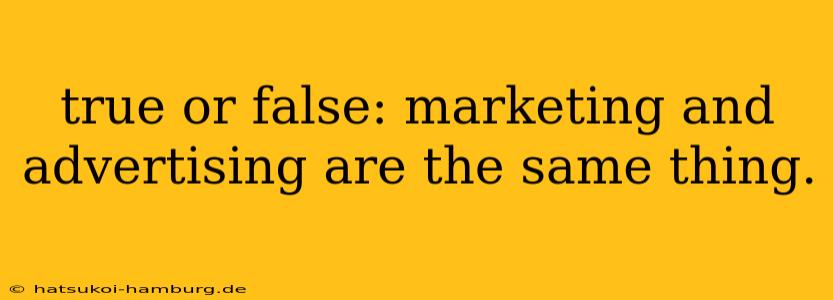Meta Description: Marketing and advertising are often used interchangeably, but they're distinct concepts. This article clarifies the difference, exploring marketing's broader scope encompassing strategy, branding, and market research, while advertising focuses on specific promotional efforts. Learn how both work together to achieve business goals.
The statement "Marketing and advertising are the same thing" is false. While closely related, marketing and advertising are distinct concepts with different roles in achieving business objectives. Many confuse the two, but understanding their differences is crucial for effective business strategy.
What is Marketing?
Marketing is the broader umbrella encompassing all activities designed to plan, price, promote, and distribute products or services to satisfy customer needs and achieve organizational objectives. It's a holistic approach that involves understanding your target audience, conducting market research, developing a brand strategy, and building customer relationships. Think of it as the overall game plan.
Key Aspects of Marketing:
- Market Research: Understanding customer needs, preferences, and behaviors.
- Brand Strategy: Creating a strong brand identity and positioning.
- Product Development: Creating and improving products or services to meet market demands.
- Pricing Strategy: Determining the optimal price point for products/services.
- Distribution Strategy: Getting your product or service into the hands of customers.
- Customer Relationship Management (CRM): Building and maintaining long-term relationships with customers.
- Public Relations (PR): Managing the public image of your company.
What is Advertising?
Advertising is a subset of marketing. It focuses specifically on paid promotional efforts to communicate with potential customers and persuade them to buy your products or services. It's one of the tools used within the larger marketing strategy.
Key Aspects of Advertising:
- Creating Ads: Designing compelling visual and textual content for various media.
- Media Selection: Choosing the right channels to reach your target audience (e.g., TV, radio, print, online).
- Budget Allocation: Determining how much to spend on different advertising campaigns.
- Campaign Measurement: Tracking the effectiveness of advertising efforts.
How Marketing and Advertising Work Together
Think of marketing as the architect designing a house, and advertising as one of the construction workers. The architect (marketing) creates the overall blueprint, while the construction worker (advertising) executes a specific part of the plan. Advertising is one tool in the larger marketing toolbox. A successful business uses both effectively. A brilliant marketing strategy is useless without effective advertising to reach the target audience. Similarly, amazing ads won't work unless they are part of a well-defined marketing strategy targeting the right people.
Analogy: Selling Lemonade
Imagine you're selling lemonade.
-
Marketing: This involves researching the best location to set up your stand, determining the ideal price point for your lemonade, understanding your target customers (kids, adults, etc.), and creating a brand for your lemonade (e.g., "Grandpa Joe's Famous Lemonade"). This also includes things like designing your stand, creating a logo, and building relationships with local businesses or community events.
-
Advertising: This includes placing flyers around the neighborhood, advertising on social media, or offering samples to attract customers. These are the specific promotional activities.
Both are vital for success. Without a solid marketing plan, your advertising efforts will be less effective. Without targeted advertising, your amazing lemonade and superb marketing may not reach the right customers.
Frequently Asked Questions (FAQs)
Q: Can you have advertising without marketing?
A: No. Advertising without a broader marketing strategy is like shooting in the dark. It lacks direction and purpose. Effective advertising is always part of a comprehensive marketing plan.
Q: What are some examples of marketing activities that are not advertising?
A: Market research, brand development, public relations, customer service improvements, and content marketing (creating blog posts, videos, etc.) are all examples of marketing activities that aren't advertising.
Q: Is social media marketing advertising?
A: Social media can be used for both marketing and advertising. Organic social media posts (those you create without paying for promotion) are marketing activities. Running paid social media ads is an advertising activity.
Conclusion
In short, marketing is the comprehensive strategy, and advertising is one of the tools used to execute that strategy. They work together to achieve business goals, but they are not interchangeable. Understanding this distinction is key to building a successful business. Remember, effective marketing and smart advertising are essential for reaching your target audience and achieving your business goals.
